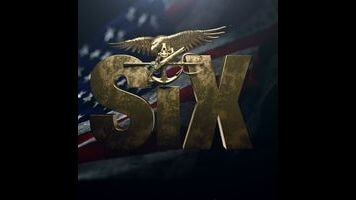Two years later Rip is working as a mercenary while the rest of the SEAL Team carries on without him. For the most part, they’re a crew of nearly indistinguishable white dudes with beards, but gradually their thin personality types emerge. Joe “Bear” Graves (Barry Sloane) is tough, humorless, and loyal; Alex Caulder (Kyle Schmid) is a surfer dude with a conscience; Ricky “Buddha” Ortiz (Juan Pablo Raba) is mere days from retirement, when he’s due to be replaced by Robert Chase (Edwin Hodge).
While working security for an American energy company opening a new school for girls in Nigeria as a publicity grab, Rip is taken hostage by the Boko Haram, along with the school’s teacher, a number of students, and a couple of American executives on hand for the opening. When word leaks out that the terrorists have captured a former SEAL, Michael Nasry (Dominic Adams), the brother of the American insurgent killed by Rip, plots his revenge. Back home, the SEAL Team members deal with domestic dramas even as they strategize Rip’s rescue.
Six was originally slated to premiere last summer, but when star Joe Manganiello, who had been cast as Rip, was forced to withdraw due to health reasons after shooting two episodes, reshoots delayed the series launch by six months. Bringing Goggins into the mix would usually be reason to rejoice, but for the most part, Six fails to take advantage of his hair-trigger energy. A wilder Rip emerges in brief flashbacks, but the present-day version is a broken man, brooding and largely passive until the plight of his fellow hostages begins to stir the embers of heroism within.
Even a subdued Goggins is a more vivid presence than most of the relative unknowns who make up the rest of the cast. To be fair, they haven’t been given much to work with in terms of rich characterizations. On the job, the SEAL Team members alternate between brotherly ball-busting back at the base and jargon-heavy “got your six” ops in the field. At home, each of the primary characters is granted a single defining domestic crisis. Bear and his wife, Lena (Brianne Davis), are grieving the loss of a child while having difficulty conceiving another. Buddha’s flip-flopping over whether to retire leads his wife, Jackie (Nadine Velazquez), to take a job, leading Buddha to bristle over her newfound independence. Free-spirit Caulder finds himself saddled with the teenage daughter he’s spent most of his life ignoring. (It unfortunately goes without saying that these female characters fare even worse than their male counterparts, in that they’re defined entirely in terms of their relationships to our SEAL Team heroes.)
With one exception, the villains are simply monstrous Muslims who hate America, given to extortion, rape, torture, and murder when they aren’t being used as cannon fodder. Even that exception, Michael, is driven primarily by personal vengeance (although to be fair, the publicity materials for Six hint at a more fleshed-out backstory that doesn’t emerge in the first four episodes). Granted, a show about Navy SEALs is necessarily going to involve Islamic extremists as antagonists, but caricatures of villainy rarely make for satisfying drama.
Women fare better behind the camera than in front of it, as the first three episodes are all helmed by female directors (Lesli Linka Glatter for the first two, Kimberly Peirce for the third). Several suspense sequences work well enough, notably an escape attempt from the Boko Haram camp. But for the most part, the action unfolds in a now over-familiar “chaos cinema” mode, all shaky camera and night vision and quick cuts that obscure rather than enhance our comprehension of each battle’s geography and logistics. By the end of the fourth hour, Six already feels like a feature film that’s been padded to meet an eight-episode order. It’s diverting at times, but nothing you haven’t seen before.
